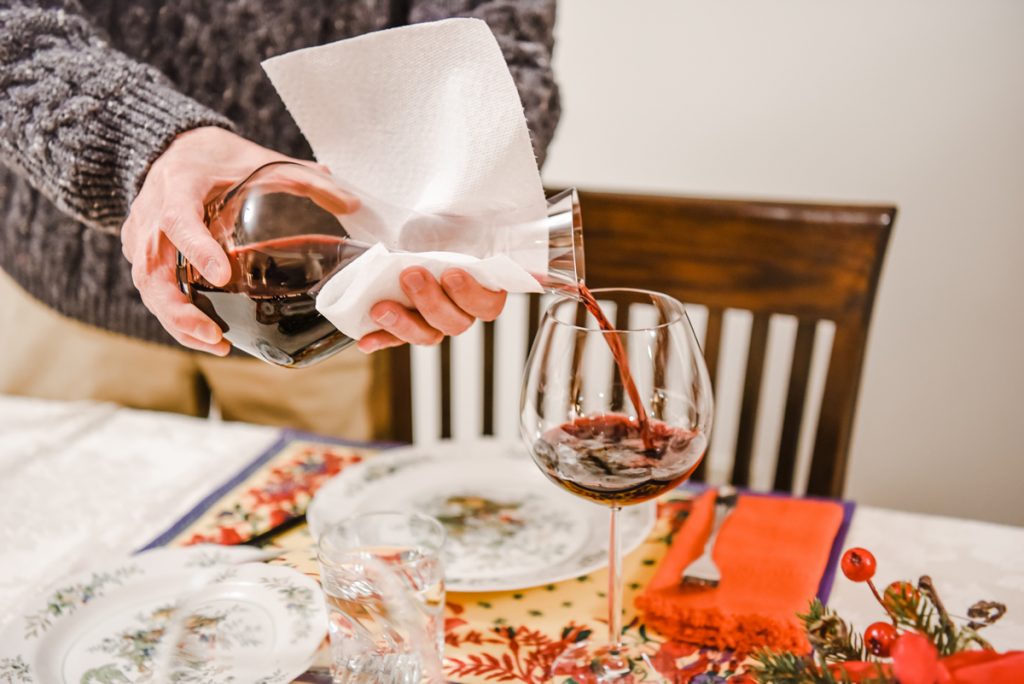
When and how to decant wines is one of the most frequently asked questions about wine. It seems like a special superpower ascribed only to sommeliers. But while it might work magic on the taste of a wine, there’s nothing mystical about it.
The premise is simple: exposure to oxygen allows a wine’s aromatic compounds to volatilize and tannins to soften. It is why swirling your wine is an essential step before you taste it. In the case of white wines or rosé, a few seconds of swirling in the glass is all you need.
When To Decant
However, red wines with fewer than five years of aging, particularly from places like Italy or the Rhone Valley in France, are often described as “tight” or lacking in complex aromas and textures on the first pour. Through decanting red wine, it becomes exposed to oxygen. Within thirty minutes, an appreciable change in the taste and structure of the wine will have occurred.
This results when tannins –the compounds that make wine taste bitter and astringent– start to polymerize or reconfigure. With greater exposure to oxygen, the tannins will soften and integrate more fully into the wine.
Best Decanters
So what is the best vessel to use when decanting a wine? First, there is absolutely no need for hand-blown crystal or hard-to-clean containers. Behind the scenes, wine folks are known to grab anything from a pitcher to a coffee pot or even a beaker from the lab. (Fancy and expensive aerators might be de rigueur these days, but not for the pros.)
Time to Decant
There is some controversy over the amount of time needed to decant properly. Certain experts believe thirty minutes is adequate, while others recommend a much longer period of time. The correct answer is: until it tastes good to you.
This is not pandering; it really depends on your tolerance for strong tannins. Some people live for astringency, yet others prefer a velvet glove approach. As long as you taste the wine every twenty to thirty minutes, you’ll be sure to find that sweet spot. Just make sure never to leave the wine unattended, as overexposure can ruin the wine.
Decanting white wine is often not recommended. There is little to be gained, and many esters lost, when you decant white wines.
Rough Decanting
Improper handling of the wine can also be detrimental. Occasionally, sommeliers will perform a “rough decant” where young, tannic wine is poured vigorously into the decanter. This can speed up aeration; however, it is too aggressive for delicate grapes like pinot noir or ancient wines.
It would help if you decanted older wines to remove sediment that accrues in the bottle over time. Stirring up the sediment will cloud a wine’s appearance and impart bitter flavors and a gritty texture. It’s not harmful, but it’s a less-than-optimal experience.
When decanting port, steer clear of rough decanting.
hyperdecanting
One wine “hack” to avoid: hyperdecanting. Using a blender to aerate wine is the brainchild of a former Silicon Valley techie (who also coined the term). While it may work in limited cases, it also has the potential to destroy your wine. Even worse, it has become the definition of an obnoxious elitist.
In sum, decanting has two aims: enhancing the flavor and structure of young, tannic wines and removing sediment from aged wines. Using simple tools and a bit of attentiveness is all you need to prepare wine like the pros.



Pingback: The Best Kosher Wineries | Great Wines from Israel
Pingback: Five Wines Loved by Sommeliers • Wine & Sommelier
Pingback: Wine Tasting Basics • Wine & Sommelier
Pingback: Decanting Wine | Learn how to decant wines the right way.